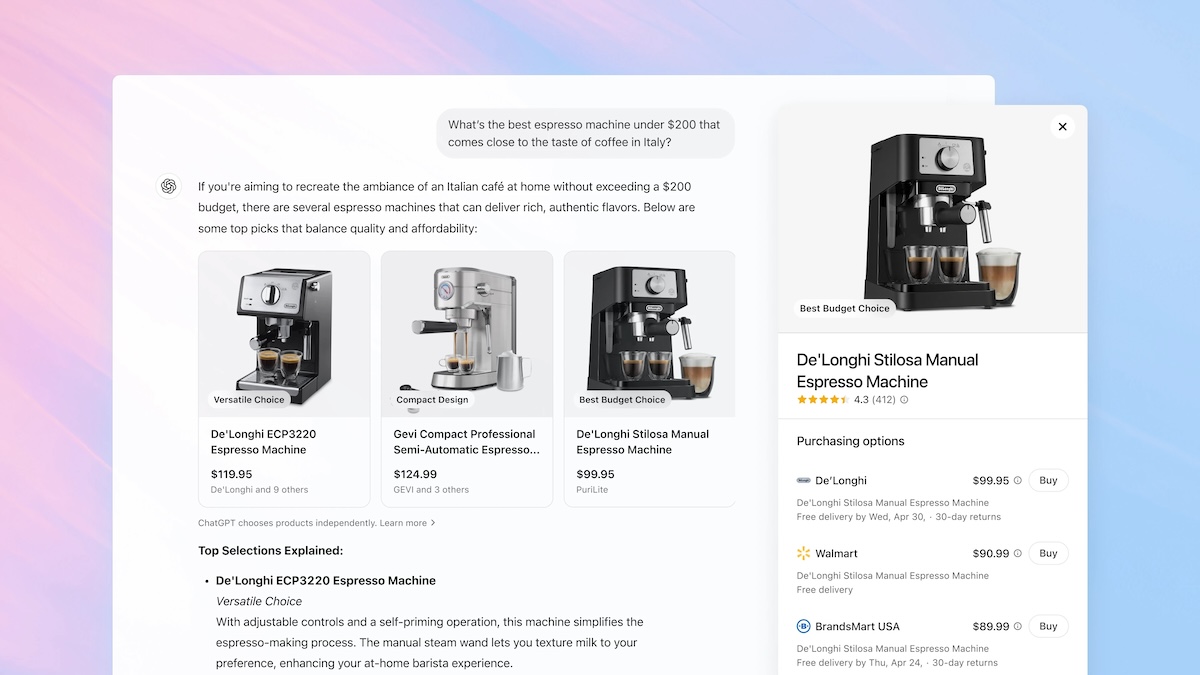The way consumers shop online is changing, and it’s changing fast. With artificial intelligence (AI) becoming more integrated into search engines, product discovery tools, and customer service platforms, today’s buyers expect more personalized, conversational, and intuitive shopping experiences.
For eCommerce brands, this shift represents both a massive opportunity and a fundamental change in how they engage with shoppers.
AI and the New Age of Consumer Discovery
Traditionally, online shopping began with keyword-based searches. A consumer types “blue floral wallpaper” into Google or Amazon, scrolls through hundreds of options, and filters results based on price or reviews.
But AI for eCommerce is flipping this model on its head.
Now, thanks to advancements in conversational search and visual recognition, consumers are beginning their journey with a simple prompt or image upload, then letting AI do the rest.
A great example? When Blue Wheel’s own CEO wanted to find affordable wallpaper that matched a specific style, he turned to ChatGPT. By uploading a photo of his existing decor and prompting the AI with a budget and style preference, he quickly received curated, shoppable suggestions, all without scrolling through dozens of irrelevant listings.

This is the future of product discovery: less friction, more personalization, and an experience that mirrors how consumers think rather than how algorithms sort.
How AI Is Transforming the eCommerce Journey
Let’s break down the most significant ways AI in eCommerce is shifting consumer behavior and what brands should be doing to keep up.
1. Conversational Search Is Replacing Traditional Browsing
Consumers are increasingly using AI chatbots for eCommerce, not just to ask support questions, but to find products in a more intuitive, dialogue-based way.
Instead of “running shoes size 8,” a shopper might say, “I’m training for a marathon and need supportive shoes that are great for long distances, and I’d like to keep the price under $150.” AI tools like ChatGPT, Google’s Gemini, or on-site eCommerce chatbots can now interpret that context and recommend the most relevant products.
For brands, this means eCommerce SEO strategies must evolve. Content needs to address natural language queries and intent-based shopping behavior, not just exact-match keywords.
Key takeaway: Optimize your product listings and content for how people talk, not just how they search.
2. AI-Powered eCommerce Tools Are Driving Hyper-Personalization
AI in eCommerce isn't just consumer-facing, but it’s powering the backend, too.
From dynamic pricing and inventory forecasting to product recommendation engines and AI-generated content, eCommerce brands now have access to tools that help them deliver deeply personalized experiences at scale.
Take AI-powered eCommerce platforms like Bloomreach or Rep AI. These platforms use behavioral data, customer segments, and real-time interactions to serve up the right offer at the right moment. Whether it’s a personalized discount, a curated collection, or an AI-driven product bundle, the result is higher conversion and greater customer satisfaction.
Key takeaway: AI tools for eCommerce are enabling brands to personalize every touchpoint, something modern shoppers have come to expect.
3. Visual Search and Generative AI Are Redefining Product Discovery
Visual search used to feel like a novelty. Now, it’s becoming standard.
Consumers can snap a photo or upload a screenshot and use AI to find visually similar items across the web. This is especially powerful in industries like fashion, home decor, and beauty, where aesthetic match often matters more than product specs.
But the real game-changer? Generative AI.
Consumers no longer need to know exactly what they’re looking for. Instead, they can describe their vision or upload a reference image, and AI will generate a curated list of suggestions, complete with clickable shopping links.

Key takeaway: Brands need to ensure their product data is optimized for image recognition and AI indexing, not just text search.
4. AI Is Elevating Post-Purchase Experiences and Loyalty
Customer service is another area where AI is transforming eCommerce.
AI chatbots for eCommerce sites are now capable of answering nuanced customer questions, handling returns, offering proactive support, and even recommending complementary products post-purchase. This kind of always-on, context-aware service keeps customers engaged and improves retention.
Key takeaway: Post-purchase is the new battleground for loyalty, and AI is helping brands win it.
Why AI in eCommerce Matters Now
AI isn’t coming for eCommerce. It’s already here. And brands that wait to adapt risk being left behind as consumer behavior continues to evolve.
Let’s look at three trends worth paying close attention to:
- Shorter funnels. Shoppers are moving from inspiration to purchase faster, often within a single AI-assisted session.
- Rising expectations. Consumers expect seamless, personalized interactions across every touchpoint.
- Decentralized discovery. Product search is happening outside of Google and Amazon, from ChatGPT to TikTok Shop and AI-powered assistants.
As Triple Whale noted, “AI is no longer a feature—it’s an expectation.”
What eCommerce Brands Need to Do Today
AI isn’t just shaping consumer behavior; instead, it’s shaping expectations. Therefore, eCommerce brands need to take proactive steps now to remain discoverable, competitive, and relevant in an AI-driven marketplace. Here are five strategic priorities to focus on today:
1. Optimize Your Product Catalog for AI Discovery
AI tools, including chatbots, visual search engines, and generative recommendation engines, rely on clean, structured data to match consumer intent with the right products. If your product information isn’t easily digestible by machines, you risk getting left out of AI-powered discovery flows.
What to do:
- Ensure product titles, descriptions, and metadata are clear, keyword-rich, and aligned with consumer language (not just technical specs).
- Use structured data markup (like Schema.org) to help AI and search engines understand and categorize your products.
- Incorporate natural language that mirrors how real customers search or speak, especially for conversational AI readiness.
Bonus tip: Include synonyms and style variations (e.g., “sofa” vs. “couch”) so AI-powered search can match a broader range of queries.
2. Integrate Conversational AI into Your Customer Experience
AI chatbots for eCommerce have advanced far beyond simple FAQs. Modern solutions now guide product discovery, recommend items based on user behavior, handle order tracking, and provide 24/7 assistance, all through natural, human-like conversations.
What to do:
- Explore AI chatbot platforms that integrate with your product feed and CRM to deliver personalized responses.
- Use conversational AI to proactively prompt users who seem stuck or hesitant during their shopping journey.
- Train your chatbot on real customer language and common objections to reduce bounce and increase conversion.
Why it matters: Shoppers who engage with AI-powered chat are significantly more likely to convert, and they tend to spend more.
3. Leverage AI Tools to Deliver Hyper-Personalized Marketing
With AI, eCommerce brands can go beyond basic segmentation and start building experiences tailored to individual behavior, preferences, and timing.
What to do:
- Use eCommerce AI tools that leverage predictive analytics to recommend products, offer discounts, or time emails based on browsing behavior.
- Build personalized email flows that adapt in real time, whether a shopper viewed a product, added it to the cart, or lapsed in activity.
- Test AI-driven content generation tools to quickly scale personalized messaging across channels.

4. Experiment with Visual and Generative AI in Product Discovery
Consumers are increasingly using screenshots, photos, or prompts instead of keywords to find what they need. If your brand isn’t prepared for visual and generative AI use cases, you’re missing opportunities for discovery.
What to do:
- Enable visual search on your eCommerce site (especially for fashion, home, and beauty brands).
- Test generative product finders or quiz-like experiences that use AI to guide shoppers to the right items based on prompts or preferences.
- Ensure your image library is optimized to maintain clean, consistent, and searchable images with high-quality alt text and captions.
Why it matters: Visual-based commerce is quickly becoming a preferred shopping method for mobile-first consumers.
5. Build an Internal AI Strategy and Roadmap
AI adoption shouldn’t just live in your tech stack; it should be part of your business strategy. Aligning your internal teams around where and how to use AI ensures long-term impact across marketing, operations, and customer experience.
What to do:
- Conduct an AI audit to assess where you're currently using AI and where there are gaps or inefficiencies.
- Create a cross-functional working group that includes marketing, product, customer service, and IT to explore AI use cases together.
- Set clear goals for AI adoption (e.g., reduce CAC, improve conversion, automate content, and shorten time to insight).
Looking ahead, brands that treat AI as a core capability, not just a plug-and-play tool, will be the ones that gain a long-term competitive advantage.
The Bottom Line
AI in eCommerce is fundamentally changing how consumers shop, and eCommerce brands that embrace these changes will be better positioned to grow in an increasingly competitive landscape.
From conversational search and personalized promotions to visual discovery and post-purchase engagement, AI is making eCommerce smarter, faster, and more intuitive.
And as Blue Wheel’s CEO recently experienced firsthand, the future of online shopping might start with something as simple as a question and a photo.
Want to explore how AI can work for your eCommerce brand? Register for our upcoming webinar: How AI & Emerging Platforms Are Rewriting the Paid Media Playbook, where Blue Wheel’s Head of DTC sits down to chat with Senior Manager of Performance Marketing at Weber to explore how emerging platforms, shifting consumer behavior, and the rise of AI are transforming the paid media landscape.







.png)
.png)
.avif)